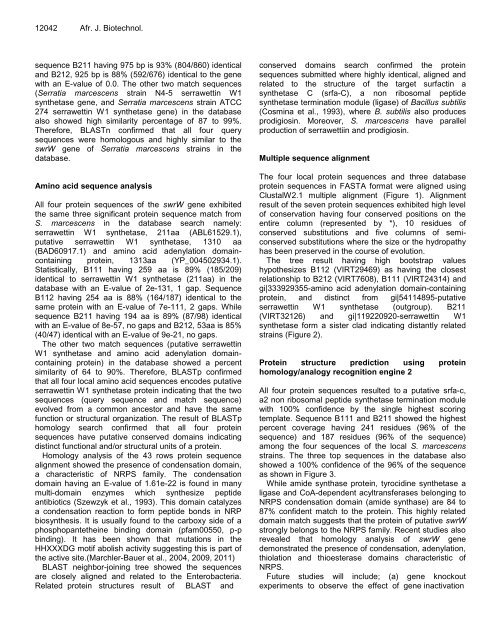Sequence analysis of putative swrW gene required for surfactant ...
Sequence analysis of putative swrW gene required for surfactant ...
Sequence analysis of putative swrW gene required for surfactant ...
You also want an ePaper? Increase the reach of your titles
YUMPU automatically turns print PDFs into web optimized ePapers that Google loves.
12042 Afr. J. Biotechnol.<br />
sequence B211 having 975 bp is 93% (804/860) identical<br />
and B212, 925 bp is 88% (592/676) identical to the <strong>gene</strong><br />
with an E-value <strong>of</strong> 0.0. The other two match sequences<br />
(Serratia marcescens strain N4-5 serrawettin W1<br />
synthetase <strong>gene</strong>, and Serratia marcescens strain ATCC<br />
274 serrawettin W1 synthetase <strong>gene</strong>) in the database<br />
also showed high similarity percentage <strong>of</strong> 87 to 99%.<br />
There<strong>for</strong>e, BLASTn confirmed that all four query<br />
sequences were homologous and highly similar to the<br />
<strong>swrW</strong> <strong>gene</strong> <strong>of</strong> Serratia marcescens strains in the<br />
database.<br />
Amino acid sequence <strong>analysis</strong><br />
All four protein sequences <strong>of</strong> the <strong>swrW</strong> <strong>gene</strong> exhibited<br />
the same three significant protein sequence match from<br />
S. marcescens in the database search namely:<br />
serrawettin W1 synthetase, 211aa (ABL61529.1),<br />
<strong>putative</strong> serrawettin W1 synthetase, 1310 aa<br />
(BAD60917.1) and amino acid adenylation domaincontaining<br />
protein, 1313aa (YP_004502934.1).<br />
Statistically, B111 having 259 aa is 89% (185/209)<br />
identical to serrawettin W1 synthetase (211aa) in the<br />
database with an E-value <strong>of</strong> 2e-131, 1 gap. <strong>Sequence</strong><br />
B112 having 254 aa is 88% (164/187) identical to the<br />
same protein with an E-value <strong>of</strong> 7e-111, 2 gaps. While<br />
sequence B211 having 194 aa is 89% (87/98) identical<br />
with an E-value <strong>of</strong> 8e-57, no gaps and B212, 53aa is 85%<br />
(40/47) identical with an E-value <strong>of</strong> 9e-21, no gaps.<br />
The other two match sequences (<strong>putative</strong> serrawettin<br />
W1 synthetase and amino acid adenylation domaincontaining<br />
protein) in the database showed a percent<br />
similarity <strong>of</strong> 64 to 90%. There<strong>for</strong>e, BLASTp confirmed<br />
that all four local amino acid sequences encodes <strong>putative</strong><br />
serrawettin W1 synthetase protein indicating that the two<br />
sequences (query sequence and match sequence)<br />
evolved from a common ancestor and have the same<br />
function or structural organization. The result <strong>of</strong> BLASTp<br />
homology search confirmed that all four protein<br />
sequences have <strong>putative</strong> conserved domains indicating<br />
distinct functional and/or structural units <strong>of</strong> a protein.<br />
Homology <strong>analysis</strong> <strong>of</strong> the 43 rows protein sequence<br />
alignment showed the presence <strong>of</strong> condensation domain,<br />
a characteristic <strong>of</strong> NRPS family. The condensation<br />
domain having an E-value <strong>of</strong> 1.61e-22 is found in many<br />
multi-domain enzymes which synthesize peptide<br />
antibiotics (Szewzyk et al., 1993). This domain catalyzes<br />
a condensation reaction to <strong>for</strong>m peptide bonds in NRP<br />
biosynthesis. It is usually found to the carboxy side <strong>of</strong> a<br />
phosphopantetheine binding domain (pfam00550, p-p<br />
binding). It has been shown that mutations in the<br />
HHXXXDG motif abolish activity suggesting this is part <strong>of</strong><br />
the active site.(Marchler-Bauer et al., 2004, 2009, 2011)<br />
BLAST neighbor-joining tree showed the sequences<br />
are closely aligned and related to the Enterobacteria.<br />
Related protein structures result <strong>of</strong> BLAST and<br />
conserved domains search confirmed the protein<br />
sequences submitted where highly identical, aligned and<br />
related to the structure <strong>of</strong> the target surfactin a<br />
synthetase C (srfa-C), a non ribosomal peptide<br />
synthetase termination module (ligase) <strong>of</strong> Bacillus subtilis<br />
(Cosmina et al., 1993), where B. subtilis also produces<br />
prodigiosin. Moreover, S. marcescens have parallel<br />
production <strong>of</strong> serrawettiin and prodigiosin.<br />
Multiple sequence alignment<br />
The four local protein sequences and three database<br />
protein sequences in FASTA <strong>for</strong>mat were aligned using<br />
ClustalW2.1 multiple alignment (Figure 1). Alignment<br />
result <strong>of</strong> the seven protein sequences exhibited high level<br />
<strong>of</strong> conservation having four conserved positions on the<br />
entire column (represented by *), 10 residues <strong>of</strong><br />
conserved substitutions and five columns <strong>of</strong> semiconserved<br />
substitutions where the size or the hydropathy<br />
has been preserved in the course <strong>of</strong> evolution.<br />
The tree result having high bootstrap values<br />
hypothesizes B112 (VIRT29469) as having the closest<br />
relationship to B212 (VIRT7608), B111 (VIRT24314) and<br />
gi|333929355-amino acid adenylation domain-containing<br />
protein, and distinct from gi|54114895-<strong>putative</strong><br />
serrawettin W1 synthetase (outgroup). B211<br />
(VIRT32126) and gi|119220920-serrawettin W1<br />
synthetase <strong>for</strong>m a sister clad indicating distantly related<br />
strains (Figure 2).<br />
Protein structure prediction using protein<br />
homology/analogy recognition engine 2<br />
All four protein sequences resulted to a <strong>putative</strong> srfa-c,<br />
a2 non ribosomal peptide synthetase termination module<br />
with 100% confidence by the single highest scoring<br />
template. <strong>Sequence</strong> B111 and B211 showed the highest<br />
percent coverage having 241 residues (96% <strong>of</strong> the<br />
sequence) and 187 residues (96% <strong>of</strong> the sequence)<br />
among the four sequences <strong>of</strong> the local S. marcescens<br />
strains. The three top sequences in the database also<br />
showed a 100% confidence <strong>of</strong> the 96% <strong>of</strong> the sequence<br />
as shown in Figure 3.<br />
While amide synthase protein, tyrocidine synthetase a<br />
ligase and CoA-dependent acyltransferases belonging to<br />
NRPS condensation domain (amide synthase) are 84 to<br />
87% confident match to the protein. This highly related<br />
domain match suggests that the protein <strong>of</strong> <strong>putative</strong> <strong>swrW</strong><br />
strongly belongs to the NRPS family. Recent studies also<br />
revealed that homology <strong>analysis</strong> <strong>of</strong> <strong>swrW</strong> <strong>gene</strong><br />
demonstrated the presence <strong>of</strong> condensation, adenylation,<br />
thiolation and thioesterase domains characteristic <strong>of</strong><br />
NRPS.<br />
Future studies will include; (a) <strong>gene</strong> knockout<br />
experiments to observe the effect <strong>of</strong> <strong>gene</strong> inactivation

















